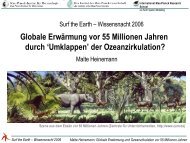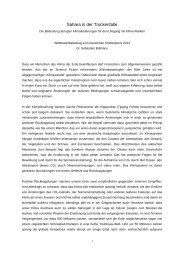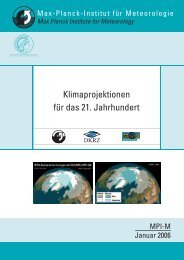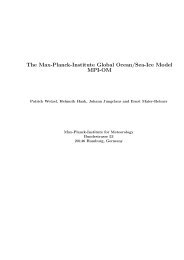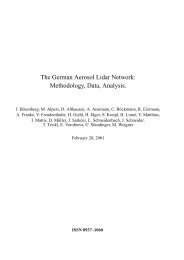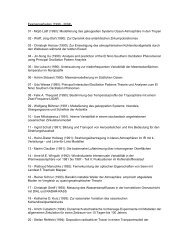Berichte zur Erdsystemforschung - Max-Planck-Institut für ...
Berichte zur Erdsystemforschung - Max-Planck-Institut für ...
Berichte zur Erdsystemforschung - Max-Planck-Institut für ...
You also want an ePaper? Increase the reach of your titles
YUMPU automatically turns print PDFs into web optimized ePapers that Google loves.
the model is underestimated. Instead we use average over two to three grid-boxes in the<br />
vicinity of each lake showing an analogue vegetation trend (Figure 5.2). The grid-boxes<br />
have been selected by applying the following criteria: a.) The averaged climate in the grid-<br />
boxes represents the local climate at the study site more appropriately (e.g. Lake Qinghai,<br />
Lake Zigetang); b.)The grid-boxes are located upstream of the study sites with respect to<br />
the atmospheric circulation system effecting the site (e.g. Lake Bangong, Lake Naleng,<br />
Lake Zigetang).<br />
5.3.2 Dynamic vegetation module<br />
The dynamic vegetation module used in this study (Brovkin et al., 2009) distinguishes<br />
eight plant-functional types (PFTs), i.e. plants are grouped with regard to their physiology<br />
including their leaf phenology type. Trees can be either tropical or extratropical and are<br />
further differentiated between evergreen and deciduous trees. The module considers two<br />
shrubby vegetation types, namely raingreen shrubs and cold shrubs. The first is limited by<br />
moisture; the second represents shrubs limited by temperature. Grass is classified as either<br />
C3 or C4 grass.<br />
For each PFT, environmental constraints are defined in the form of temperature thresholds<br />
representing their respective bioclimatic tolerance. These thresholds define the area, where<br />
establishment of a PFT is possible. They describe cold resistance by the lowest mean<br />
temperature of the coldest month (Tcmin), chilling requirements by the maximum mean<br />
temperature of the coldest month (Tcmax) and heat requirement for the growth phase. The<br />
latter is considered via the summation of temperature over days with temperature higher<br />
than 5°C, called growing degree days (GDD5). Cold shrubs are also excluded in regions<br />
with warm climate (Twmax). The values of the limits are listed in Table 5.1 and similar to<br />
the limits used in the biosphere model LPJ (Sitch et al., 2003).<br />
For each grid-box of the atmosphere, the land surface is tiled in mosaics, so that several<br />
PFTs can be represented in a single grid cell. The fractional cover of each PFT is<br />
determined by the balance of their establishment and mortality. The latter is the sum of the<br />
mortality by the aging of plants and the disturbance-related mortality (fire and windbreak).<br />
The establishment is calculated from the relative differences in annual net primary<br />
productivity (NPP) between the PFTs and hence includes the different moisture<br />
requirements of the plants. Furthermore, the establishment is weighted by the inverse of<br />
the PFT specific lifetime, i.e. plants that live long establish slowly. The establishment of<br />
woody PFTs is favoured over grass, so that grass can only establish in the area, which is<br />
left after trees and shrubs have established. In the absence of disturbances, woody PFTs<br />
thus have an advantage over grasses and the woody PFT with the highest NPP becomes the<br />
dominant vegetation-type in the grid-box. Generally, trees have the highest NPP, since<br />
they have the largest leaf-area. However, in regions with frequent disturbances or in<br />
84



